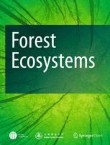Dead standing pine trees in a boreal forest landscape in the Kalevala National Park, northern Fennoscandia: amount, population characteristics and spatial pattern
After their death, Scots pine trees can remain standing for decades and sometimes up to 200 years, forming long-lasting and ecologically important structures in boreal forest landscapes. Standing dead pines de...
